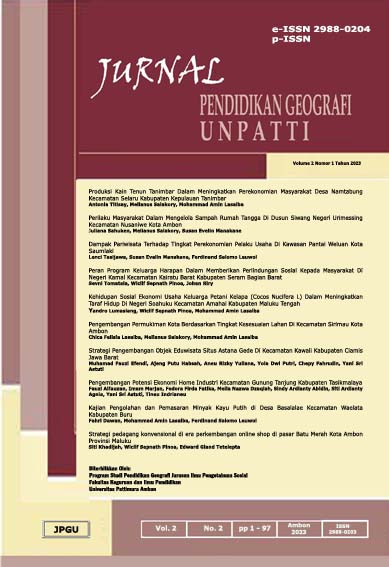Meti Kei Festival: Cultural Study and Development in Ngilngof Village, Manyeuw District, Southeast Maluku Regency
Festival Meti Kei Telaah Kultural dan Pengembangannya di Desa Ngilngof Kecamatan Manyeuw Kabupaten Maluku Tenggara
Abstract
One of the cultural tours that is there is the meti kei festival, for this reason, in this study will be studied by the cultural pelasanan festifal meti kei which will be studied descriptively qualitatively to provide explanations and descriptions by waiting for qualitative descriptive analysis techniques using an Interpretive approach that focuses on the interpretation of human actions that have deep meaning. With the research subject used is Purposive Sampling,where data sampling with certain considerations. Namely, 1 employee of the Tourism office of Southeast Maluku Regency, 1 employee of the Southeast Maluku Regency cultural service, 2 ngilngof village people and the Head of ohoi ngilngof as informants. As for the results of this study as the author describes, preliminary conclusions can be obtained on the implementation of meti kei in the kei islands, namely in October 2017 tepanya in Ohoi Ngilngof. Festifal begins with the custom of kasinaik siri pinag followed by the Wer Warat (Fish Capture together) process as well as various arts and regional specialties displayed
Downloads
References
Arikunto. (2006). Prosedur Penelitian: Suatu Pendekatan Praktik. Jakarta: Rineka Cipta
Hamidi. (2004). Metode Penelitian Kualitatif: Aplikasi Praktis Pembuatan Proposal Dan LaporanPenelitian. Malang: UMM Press. 72.
Saifuddin, Achmad Fedyani. (1997). A ntropologi Kontemporer : Suatu Pengantar Kritis Mengenai Paradigma,. Jakarta: Prenada Media.
Sugiyono. (2012). Metode PenelitianKuantitatif, Kualitatif dan R&D. Bandung.
Sugiyono. (2006). Metode Penelitian Bisnis. Cetakan Kelima. Bandung : CV.Alfabeta.
Sugiyono. (2014). Statistika untuk Penelitian” Buku. PenerbitALFABETA. Bandung.

